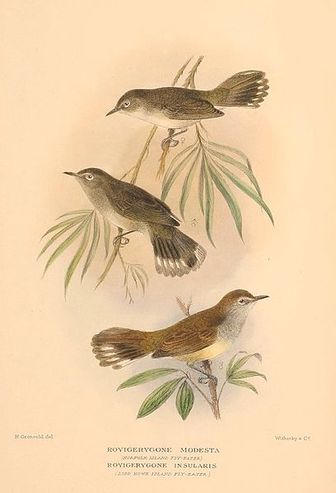Lord Howe Gerygone

The Lord Howe Gerygone is classified as Extinct (EX), there is no reasonable doubt that the last individual has died.
One species, the Lord Howe Gerygone (Gerygone insularis), is extinct; and 25 taxa in 17 species are considered endangered, three of them critically so. The primary threats are land clearing, overgrazing, degredation and fragmentation of habitat, and changing fire regimes. The taxonomy of the Pardalotidae is complex and classifications have changed a great deal over the years. More
* Lord Howe Gerygone, Gerygone insularis Conservation status: Extinct (c. More
Lord Howe Gerygone The Lord Howe Gerygone (Gerygone insularis) was a species of bird in the Pardalotidae family. It was endemic to Australia. See more at Wikipedia.org... This article uses material from Wikipedia® and is licensed under the GNU Free Documentation License Wikipedia Português A enciclopédia livre Download this dictionary Gerygone insularis Gerygone insularis foi uma espécie de ave da família Pardalotidae. Foi endémica da Austrália. Veja mais na Wikipédia.org... More
Lord Howe Gerygone Gerygone insularis 2009 IUCN Red List Category (as evaluated by BirdLife International - the official Red List Authority for birds for IUCN): Extinct Family/Sub-family Acanthizidae Species name author Ramsay, 1879 Taxonomic source(s) Brooks (2000), Christidis and Boles (1994), Sibley and Monroe (1990, 1993) Summary Gerygone insularis was an abundant endemic to Lord Howe Island, Australia, until the island was colonised by rats from a shipwreck in 19185. More
* Lord Howe Gerygone Gerygone insularis ^ * Southern Boobook (Lord Howe Is. subsp.) Ninox novaeseelandiae albaria ^ * White Gallinule Porphyrio albus ^ * Grey Fantail (Lord Howe Is. subsp.) Rhipidura fuliginosa cervina ^ * Island Thrush (Lord Howe Is. subsp. More
Lord Howe Gerygone, Gerygone insularis - extinct (c. More
Family : Acanthizidae
Genus : Gerygone
Species : insularis
Authority : Ramsay, 1879
